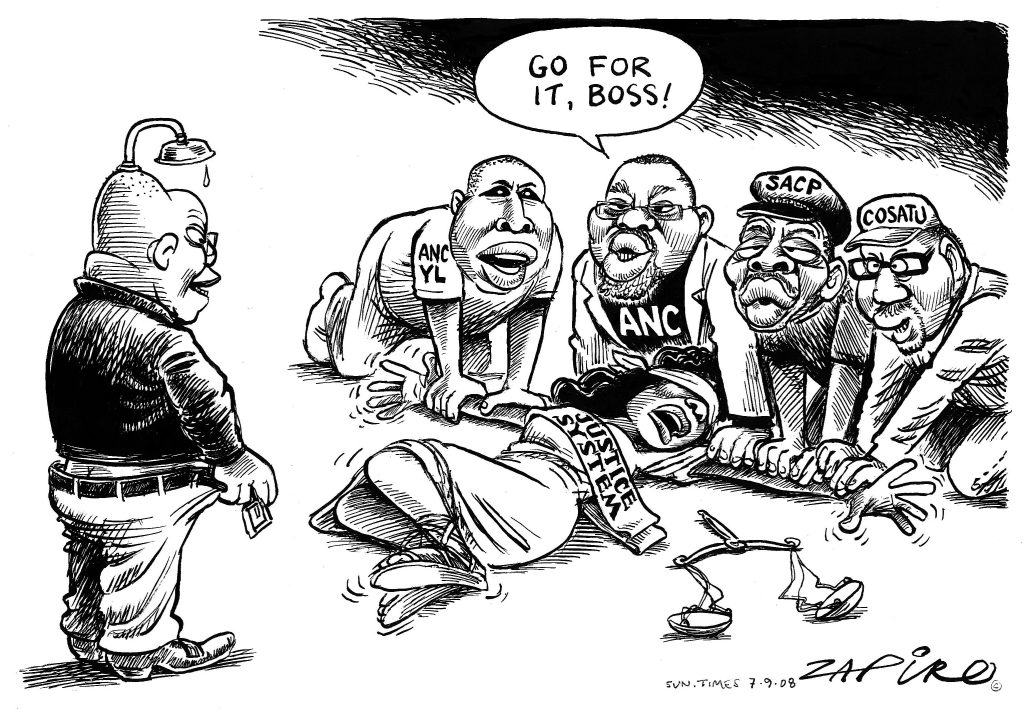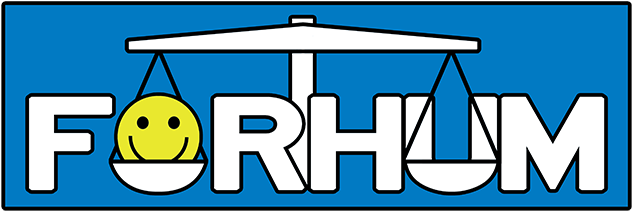
Mode of expression: Cartoon
Publication: The Sunday Times
Region: South Africa
Relevant dates: 7 September 2008 (publication), 2012 (lawsuit dropped)
Outcome: Lawsuit dropped
Judicial body: High Court of South Africa
Type of law: Civil Law
Themes: Defamation / Reputation / Infliction of Emotional Distress / Satire
Context and legal case
The cartoon The Rape of Lady Justice by the renowned South African cartoonist Zapiro was published in the South African newspaper The Sunday Times on 7 September 2008. It depicts Jacob Zuma – then the president of the African National Congress (ANC), and later the President of South Africa – unbuttoning his pants while four men hold down a woman representing Lady Justice, implying that Zuma is about to rape Lady Justice with their assistance and encouragement. The four men were key Zuma supporters in the ANC-led Tripartite Alliance: from left to right, Julius Malema (then leader of the ANC Youth League), Gwede Mantashe (then ANC Secretary General), Blade Nzimande (General Secretary of the South African Communist Party) and Zwelinzima Vavi (General Secretary of the Congress of South African Trade Unions). The cartoon depicts Mantashe telling Zuma to “Go for it, boss!”
In 2006, Zapiro had started drawing Zuma with a shower head sprouting from his skull. hat year, Zuma had been controversially acquitted on rape charges. He did, however, admit that he had sex with his accuser, who was HIV-positive, but had claimed that he had taken a shower afterwards to prevent an infection.
The cartoon was published during other court proceedings, concerning criminal charges against Zuma: he faced twelve fraud charges, two corruption charges, and one charge each of racketeering and money laundering. Any criminal conviction would have prevented Zuma from standing as a candidate in the 2009 presidential election. In the months leading up to the verdict, Zuma’s political allies made numerous public threats and ad hominem attacks against the judiciary. Malema and Vavi stated that they would “kill for Zuma” if the case went ahead while Mantashe called the Constitutional Court judges counter-revolutionaries and stated that anarchy would break out in South Africa if Zuma was convicted. Nzimande stated that the trial threatened South Africa’s political stability.
Shortly after the cartoon’s publication, Zuma sued Zapiro for R4 million due to the alleged damage it caused his reputation and an additional R1 million for injury to his dignity. The claim was later reduced by Zuma to R100 000 and an apology. In 2012, the lawsuit was dropped altogether, with an official statement explaining that Zuma’s decision “was informed by the broader agenda of reconciliation.”
Analysis
Despite the declaration, the charges were likely dropped because it was politically inopportune for Zuma to go head-to-head with South Africa’s most celebrated cartoonist. In fact, it seems that Zuma might have fallen victim to the so-called Streisand Effect. Named after Barbra Streisand’s failed attempt in 2003 to suppress the publication of a photograph showing her clifftop residence in Malibu, California, the Streisand Effect refers to an attempt to remove or censor information that backfires, leading to increased public awareness). Zuma’s outspoken indignation at the fact that he had been caricatured with a shower head, and his public attempts to sue Zapiro, only spurred the cartoonist on. Zapiro continued to use the shower head in images depicting Zuma and even developed an entire series of Rape of Lady Justice cartoons following the 2008 original.
Sources and further reading:
Rodwell Makombe. “Images of a nation in crisis: A critical analysis of Zapiro’s Rape of Lady Justice cartoons,” Communicare: Journal for Communication Studies in Africa 37.1 (2022): 56-73. https://journals.co.za/doi/pdf/10.10520/EJC-105748935d
